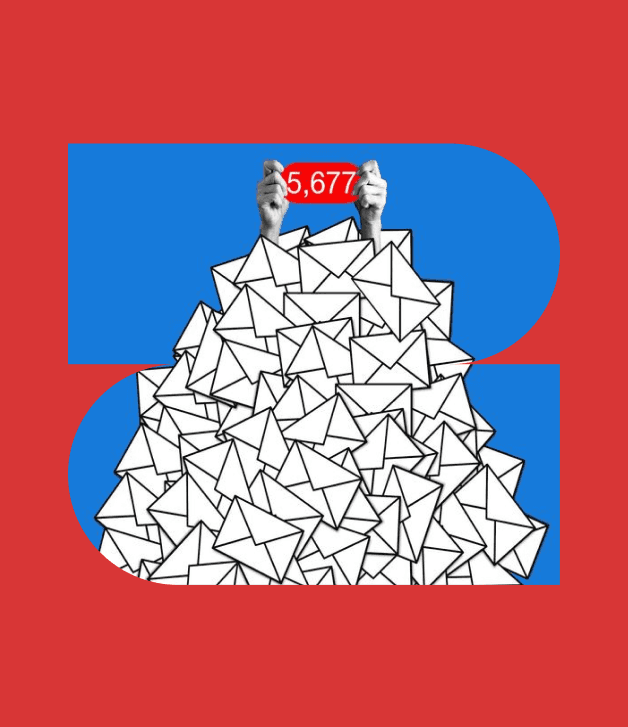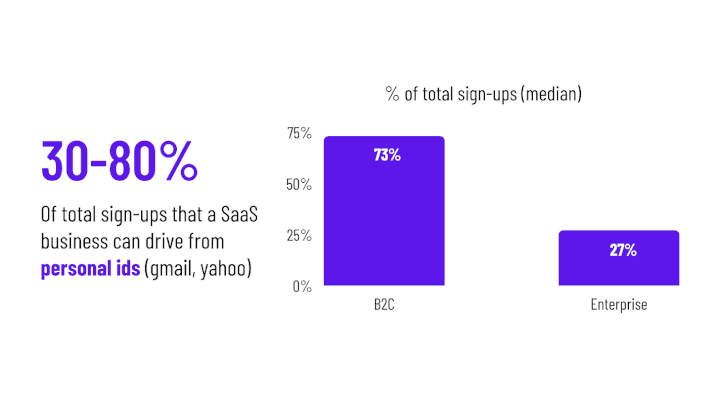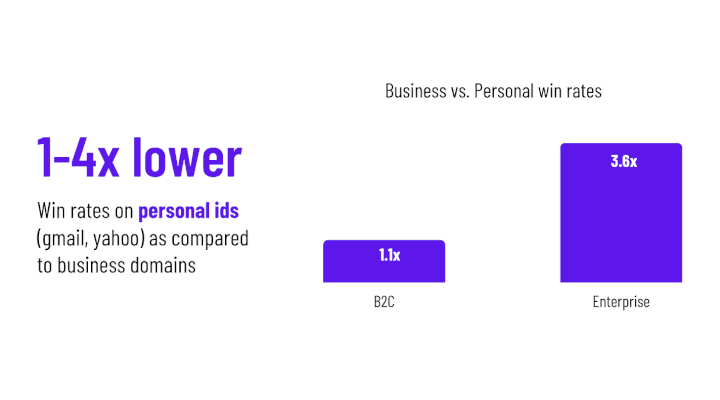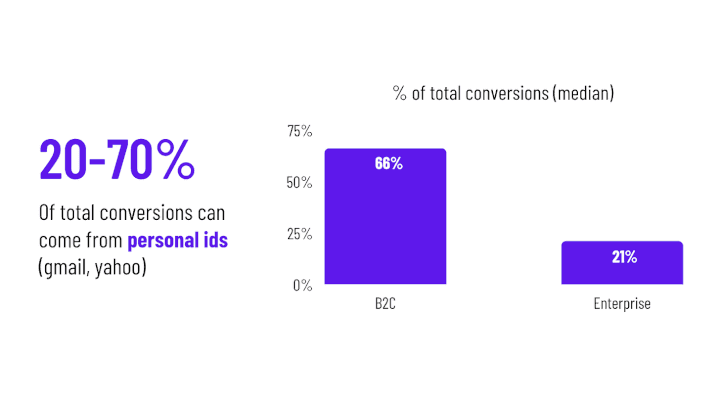Here's why you shouldn't be ignoring your g-mail sign-ups
Here's why you shouldn't be ignoring your g-mail sign-ups
Here's why you shouldn't be ignoring your g-mail sign-ups
You might be leaving 15-70% of your conversions on the table.
You might be leaving 15-70% of your conversions on the table.
You might be leaving 15-70% of your conversions on the table.



Hey, Ruchin here! Welcome back to Toplyne Labs - Edition #3
A weekly digest that covers unique insights on what makes PLG businesses tick, what signals make for the best PQLs, what sales teams get right, what they get wrong, and the meaning of life… Go figure 🤷🏻♂️
This week, we look at data from over 5M users to answer a question that all PLG companies ask themselves every now and then - especially as they look down their list of new sign-ups:
"WTH do we do with all these personal e-mail sign-ups?"
Disclaimer: While this analysis spans over 5.M users, it also captures a breadth of behaviour across various categories of PLG products. We encourage you to use these insights directionally and thematically.
Insight #1: Do you block Gmail logins? You might be turning away 30-80% of signups
If you’re a sales or demand generation team, personal email ids are your friend.
They can expand your top-of-funnel by 30-80% - irrespective of whether you’re a B2C or enterprise business.

Insight #2: But Gmail signups have 1-3x lower conversion rates
No doubt, Gmail IDs add noise to the funnel.
You don’t know which company they work at, how large the company is, how much they’ve raised, yada yada.
Traditional profiling and legacy third-party enrichment just don’t work.

But that sounds like a YOU PROBLEM 😬
Because boy, do these leads convert.
Depending on B2C/Enterprise, personal email id signups can account for 20-70% of total conversions.
It’s your job to find these users… vs. expecting these users to find you (?!) whutt 🤨

Insight #3: Gmail win rates can be a LOT better
The best PLG sales teams close personal and business domain leads at equal win rates 🤯 How?
Let’s get real for a second. A large % of the Gmail signups you let through the door will never convert.
As a PLG company, it’s your job to identify those who would. The carrot at the end of the stick - 20-70% of your potential conversions.
But traditional lead scoring fails in doing this. It relies too heavily on the BANT framework - a legacy qualification framework based on Budget, Authority, Need, and Timeline.
Traditional lead scoring indexes heavily on Budget and Authority. But with Gmail signups, you know a lot less about:
Budget: You have no idea which company this person works for, how large they are, or how much they’ve raised?
Authority: Is this signup in a CXO, VP-level position, or an entry-level role?
But as a PLG company, you have a lot of knowledge about the Need and Timeline your prospect is working with.
Hell, your potential customer is already a user of your product!
Tapping into product usage data is the need of the hour.
All you need to do is train an AI to scan through the millions of clicks within your product to spot users who have shown the highest proclivity to buy.
Here’s how you do it:
The talent you’ll need:
A data engineer or two - a few $100k.
Hire a data scientist or two - a few $100k.
What these folks would need to do:
Set up pipelines to sync and stitch together all your product usage and customer data in a warehouse - a few $10-100k.
Train AI models to scan through the data on Snowflake and identify users most likely to convert based on historic patterns in conversions.
Set up a live data sync into your CRMs with a rev-ETL tool.
(OPTIONAL) Set up a performance tracking and A/B testing framework - no points for guessing, the more you iterate the better the results.
The stack you’ll need (representative) - Fivetran, Snowflake, AWS, dbt, MLflow, rev-ETL tools, etc, etc.
OR…..
You could just signup for Toplyne and we’ll have this set up and ready in 7 days 🤷🏻♂️
Hey, Ruchin here! Welcome back to Toplyne Labs - Edition #3
A weekly digest that covers unique insights on what makes PLG businesses tick, what signals make for the best PQLs, what sales teams get right, what they get wrong, and the meaning of life… Go figure 🤷🏻♂️
This week, we look at data from over 5M users to answer a question that all PLG companies ask themselves every now and then - especially as they look down their list of new sign-ups:
"WTH do we do with all these personal e-mail sign-ups?"
Disclaimer: While this analysis spans over 5.M users, it also captures a breadth of behaviour across various categories of PLG products. We encourage you to use these insights directionally and thematically.
Insight #1: Do you block Gmail logins? You might be turning away 30-80% of signups
If you’re a sales or demand generation team, personal email ids are your friend.
They can expand your top-of-funnel by 30-80% - irrespective of whether you’re a B2C or enterprise business.

Insight #2: But Gmail signups have 1-3x lower conversion rates
No doubt, Gmail IDs add noise to the funnel.
You don’t know which company they work at, how large the company is, how much they’ve raised, yada yada.
Traditional profiling and legacy third-party enrichment just don’t work.

But that sounds like a YOU PROBLEM 😬
Because boy, do these leads convert.
Depending on B2C/Enterprise, personal email id signups can account for 20-70% of total conversions.
It’s your job to find these users… vs. expecting these users to find you (?!) whutt 🤨

Insight #3: Gmail win rates can be a LOT better
The best PLG sales teams close personal and business domain leads at equal win rates 🤯 How?
Let’s get real for a second. A large % of the Gmail signups you let through the door will never convert.
As a PLG company, it’s your job to identify those who would. The carrot at the end of the stick - 20-70% of your potential conversions.
But traditional lead scoring fails in doing this. It relies too heavily on the BANT framework - a legacy qualification framework based on Budget, Authority, Need, and Timeline.
Traditional lead scoring indexes heavily on Budget and Authority. But with Gmail signups, you know a lot less about:
Budget: You have no idea which company this person works for, how large they are, or how much they’ve raised?
Authority: Is this signup in a CXO, VP-level position, or an entry-level role?
But as a PLG company, you have a lot of knowledge about the Need and Timeline your prospect is working with.
Hell, your potential customer is already a user of your product!
Tapping into product usage data is the need of the hour.
All you need to do is train an AI to scan through the millions of clicks within your product to spot users who have shown the highest proclivity to buy.
Here’s how you do it:
The talent you’ll need:
A data engineer or two - a few $100k.
Hire a data scientist or two - a few $100k.
What these folks would need to do:
Set up pipelines to sync and stitch together all your product usage and customer data in a warehouse - a few $10-100k.
Train AI models to scan through the data on Snowflake and identify users most likely to convert based on historic patterns in conversions.
Set up a live data sync into your CRMs with a rev-ETL tool.
(OPTIONAL) Set up a performance tracking and A/B testing framework - no points for guessing, the more you iterate the better the results.
The stack you’ll need (representative) - Fivetran, Snowflake, AWS, dbt, MLflow, rev-ETL tools, etc, etc.
OR…..
You could just signup for Toplyne and we’ll have this set up and ready in 7 days 🤷🏻♂️
Related Articles




Behavioral Retargeting: A Game-Changer in the Cookieless Era
Unlock the power of behavioral retargeting for the cookieless future! Learn how it personalizes ads & boosts conversions. #behavioralretargeting




All of Toplyne's 40+ Badges in the G2 Spring Reports
Our customers awarded us 40+ badges in G2's Summer Report 2024.




Unlocking the Full Potential of Google PMax Campaigns: Mastering Audience Selection to Double Your ROAS
Copyright © Toplyne Labs PTE Ltd. 2024
Copyright © Toplyne Labs PTE Ltd. 2024
Copyright © Toplyne Labs PTE Ltd. 2024
Copyright © Toplyne Labs PTE Ltd. 2024